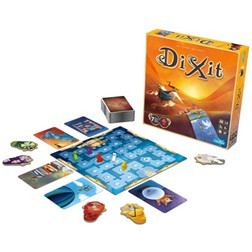
- Year published: 2008
- Number of players: 2-4
- Age: 8+
- Time: 30 minutes
- Genre: Storytelling
The game does not take us into a specific world, but lets us put the cards into the world we imagine. Then we can turn it into anything we want, anything we can relate to. The textures and images on the cards are enchantingly beautiful, flying, and sometimes a bit ghostly, and especially not tied to any framework. That is like creating a stimulant that helps our minds to open up, becoming the ingredients for us to create our inner world.
And of course, the job of the other players is to try to get into that world, by making connections from the fact that you know each other, to find the picture that matches your picture. Dixit is where hundreds of worlds are created, where they harmonize and bring people closer together. The most special feature of the game probably comes from the fact that it...is extremely simple. Therefore, there is no limit to the player's imagination. Only the way to calculate the score needs to be regulated, and in my opinion, that rule is what makes the game so much more attractive.
First, you still need a little "tactical" in your storytelling, because the rule is that if no one or everyone can guess your picture, you don't get points. That means you have to tell your story so that your story is not too complicated or hidden (for no one to guess), but also not too simple (everyone can see it). A hint is just enough of a hint, and focusing on what you think only 1 of the players knows the answer to will be a reasonable tactic to score points and thwart other players.
Also, for other players, the most important thing you need to do when you have a narrator is to find the picture that best matches the narrator's suggestion from among the cards in your hand. That way, you'll get a lot of people to believe that it's the narrator's picture, and earn a lot of extra points.











Comments
0 comment